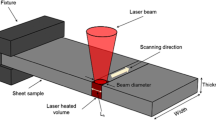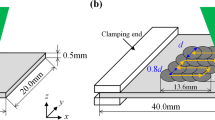Abstract
Laser application in sheet metal bending represents a flexible forming method, which does not require specialized mechanical tools or large external forces. Whereas the required process parameters leading to simple bending geometries can be estimated to some extent by analytical models, for complex structures it is mostly not possible. A sufficient planning flexibility is generally provided by numerical simulation, yet particularly time-consuming if applied to incremental processes. To optimize this, an extended understanding of the material response during laser beam bending is required. Based on in situ strain and temperature measurements an analysis of incremental stress behavior is undertaken at multiple positions on the laser averted surface. For transient temperature recording a thermal camera is used. The surface strains are continuously detected by an ARAMIS-system. To calculate stress values an approach is proposed, which adapts Hook’s law on stress and strain for two-dimensions and which is further enhanced by plastic strain state and temperature changes. An analysis is provided for stainless steel (1.4301) and pure aluminum (EN AW-1050A), as well as for two cooling time periods in-between cycles. The incremental behavior of localized transversal stresses proves to be particularly complex. In contrast, longitudinal stresses approach a recurring incremental behavior pattern after very few initial laser scans. Furthermore, an indication on a material specific evolution of the plastic zone geometry is won.












Similar content being viewed by others
References
Altenpohl D (1965) Aluminium und Aluminiumlegierungen, Reine und angewandte Metallkunde in Einzeldarstellungen, Band 19, Heidelberg, pp 547–570
Edwardson SP, Watkins KG, Dearden G, French P (2003) Strain gauge analysis of laser forming. J Laser Appl 15(8):225–232
Edwardson SP, Moore AJ, Abed E, McBride R, French P, Hand DP, Dearden G, Jones JDC, Watkins KG (2004) Iterative 3D laser forming of continuous surfaces. In: Proceedings of the 23rd ICALEO, laser forming, pp 36–45
Geiger M, Kraus J, Vollertsen F (1994) Laserstrahlumformen räumlicher Bauteile. Bestrahlungsreihenfolge wichtig. Bänder Bleche Rohre 35(11):26–37
Hennige T, Holzer S, Vollertsen F, Geiger M (1997) On the working accuracy of laser bending. J Mater Process Technol 71(3):422–432
Hennige T (2000) Development of irradiation strategies for 3D-laser forming. J Mater Process Technol 103:102–108
Hirt G (ed) (2010) In: Hirt G (ed) Modelling of incremental forming processes. Shaker, Aachen
Holzer S (1996) Berührungslose Formgebung mit Laserstrahlung. Meisenbach, Bamberg
Jeswiet J, Geiger M, Engel U, Kleiner M, Schikorra M, Duflou J, Neugebauer R, Bariani P, Bruschi S (2008) Metal forming progress since 2000. CIRP J Manuf Technol 1:2–17
Mäder HF (1972) Experimentelle spannungsanalyse temperaturbelasteter bauteile durch dehnungsmessungen, chemie ingenieur technik, 44.Jahrgang, Heft 3, 97–144
Namba Y (1986) Laser forming in space. In: Wang CP (ed.) Proceedings of the international conference on lasers’85, pp 403–407
Neugebauer R, Scheffler S, Poprawe R, Weisheit A (2009) Local lase heat treatment of high strength steels to improve formability, (WGP). Prod Eng Res Devel 3:347–351
Ueda T, Sentoku E, Yamada K, Hosokawa A (2005) Temperature measurement in laser forming of sheet metal, CIRP Ann Manuf Technol 54/1:179–182
Vollertsen F (1996) Laserstrahlumformen, lasergestützte Formgebung: Verfahren, Mechanismen, Modellierung. Meisenbach, Bamberg
Vollertsen F, Grden M (2010) Efficient simulation method for incremental thermal sheet bending using plasma. In: Hirt G (ed.) Modelling of incremental forming processes. Shaker, Aachen, pp 75–94
Untersuchung relevanter Einflußgrößen auf die numerische Schweißsimulation (2006) Forschungsberichte des Instituts für Schweißtechnik B. 3. Shaker, Aachen, p 152ff
Yang LJ, Wang Y, Wang ML, Chen YB (2008) Research on 3D laser forming of square metal sheet to spherical dome. Thermal forming and welding distortion. In: Proceedings of the IWOTE’08, BIAS, pp 241–251
Zaeh MF, Hornfleck T (2008) Development of a robust laser beam bending process for aluminum fuselage structures, (WGP). Prod Eng Res Devel 2:149–155
Acknowledgments
We acknowledge the DFG (Deutsche Forschungsgemeinschaft) for the financial support of the project VO 530/47-1.
Author information
Authors and Affiliations
Corresponding author
Rights and permissions
About this article
Cite this article
Tetzel, H., Grden, M. & Vollertsen, F. Stress analysis based on strain measurement in sheet metal laser bending. Prod. Eng. Res. Devel. 7, 647–655 (2013). https://doi.org/10.1007/s11740-013-0488-9
Received:
Accepted:
Published:
Issue Date:
DOI: https://doi.org/10.1007/s11740-013-0488-9




